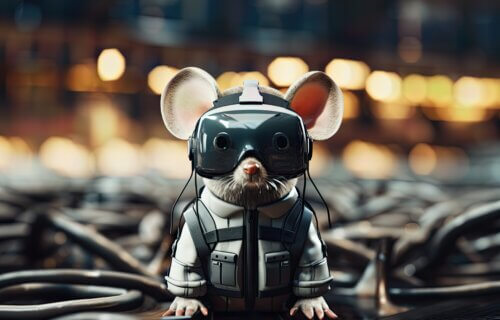ASHBURN, Va. — Rats possess imaginations similar to humans, researchers have discovered. Their experiments demonstrated that rats could use their minds to perform tasks in a virtual reality environment.
A team in Virginia developed an innovative system combining virtual reality with a brain-machine interface, allowing them to explore the cognitive abilities of lab rodents. Their findings reveal that rats, much like humans, can think about places and objects that are not immediately present, essentially using their imaginations to picture what they want to see.
The study also discovered that rats could use their minds to move objects within the VR world, reminiscent of the feats Jedis in “Star Wars” are capable of performing. This research provides evidence that not only rats, but possibly other animals as well, have imaginative capabilities similar to humans.
Researchers from the Howard Hughes Medical Institute’s Janelia Research Campus found that brain activity in rodents, akin to humans, is activated when they experience new places and events. This neural activity is centered in the hippocampus, an area of the brain responsible for spatial memory.
The study indicates that rats can voluntarily generate activity patterns in the hippocampus to recall remote locations. This ability to imagine locations distant from our current position is crucial for recalling past events and envisioning future scenarios.
The authors of the study assert that this finding demonstrates that animals possess imaginations. The research began nearly a decade ago when Dr. Chongxi Lai arrived at the Janelia campus and collaborated with Dr. Albert Lee to explore the possibility of animals being capable of thought.
Together, they developed a “thought detector” system to measure neural activity and interpret animal thoughts. This system utilizes a brain-machine interface (BMI), creating a direct link between brain activity and an external device. The BMI connects the electrical activity in the rat’s hippocampus with its position in a 360-degree virtual reality arena. The hippocampus is known for storing mental maps and is involved in memory recall and future scenario planning.
Memory recall involves generating specific hippocampal activity patterns related to places and events. However, it was unknown whether animals could voluntarily control this activity until this study. The researcher’s BMI allowed them to assess whether a rat could activate hippocampal activity to think about a location in the arena without physically being there, effectively testing the animal’s ability to imagine going to that location.
The researchers also created a “thought dictionary” to decode the rat’s brain signals, correlating activity patterns with experiences in the VR arena. The rat, harnessed in the VR system, walked on a spherical treadmill, and its movements were translated onto the 360-degree screen. Successful navigation to a goal was rewarded.
At the same time, the BMI system recorded the rat’s hippocampal activity, enabling researchers to monitor which neurons were activated as the rat navigated the arena. These signals formed the basis for a real-time hippocampal BMI, translating brain activity into actions on a screen.
The research team then disconnected the treadmill and rewarded the rat for reproducing hippocampal activity patterns associated with a goal location in real life. In this “Jumper” task, named after the 2008 film, the BMI translated the animal’s brain activity into motion on the virtual reality screen. The rats effectively used their thoughts to navigate towards rewards by first thinking about where they needed to go, a thought process commonly experienced by humans.
“The rat can indeed activate the representation of places in the environment without going there. Even if his physical body is fixed, his spatial thoughts can go to a very Even if his physical body is fixed, his spatial thoughts can go to a very remote location.” says the study’s first author, Dr. Lai, in a media release.
In another task, named the “Jedi” task as a nod to the Star Wars films, the rat moved an object to a location by thoughts alone. The rat was fixed in a virtual place but “moved” an object to a goal in the VR space by controlling its hippocampal activity. The researchers then changed the goal location, requiring the animal to produce activity patterns associated with the new location. The team found that rats could precisely and flexibly control their hippocampal activity, similar to humans.
The animals also sustained this hippocampal activity, holding their thoughts on a given location for many seconds, similar to the timeframe at which humans relive past events or imagine new scenarios.
“To imagine is one of the remarkable things that humans can do. Now we have found that animals can do it too, and we found a way to study it,” adds Dr. Lee, an HHMI Investigator at Beth Israel Deaconess Medical Center.
The research not only demonstrates that BMI can probe hippocampal activity but also opens up the possibility of designing novel prosthetic devices based on similar principles.
The study is published in the journal Science.
You might also be interested in:
- All-natural inspiration: Study finds drugs fail to spark creativity and imagination
- Best VR Headsets: Top 5 Immersive Devices Most Recommended By Tech Experts
- Best VR Games: Top 7 Immersive Titles Most Recommended By Experts
South West News Service writer James Gamble contributed to this report.


Yes I believe that rats or mice animals have imaginations just like humans. I truly believe that we are not that much different than the animals, I mean why would they not have an imagination? We’re not that special that they cannot have an imagination I mean really.? Wow we’re not that special that we’re the only ones allowed to have an imagination. Wow I’m sure some people believe that they are that Superior and that is something else. Nick the painter